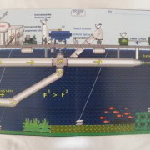 Neil Harrison Jun 15, 2014 10:52 |
An interesting idea that may have promise despite the engineering challenges. However, let me suggest some problems and effects you may not have considered and a different approach to funding and management of the project. First, possible problems. If you would be able to harness 1% of the thermal energy in the Gulf Stream would this have any effect on the countries and locales that benefit from its warming? Would capture of some of the kinetic energy slow down the Gulf Stream and how would that affect energy transfer to Northern Europe? There is already concern that warming may slow the Gulf Stream down with consequentially massive effects on local and regional (and possibly global) climates. Would your geoengineering cause the same effects that it is intended to prevent?
As for financing you are suggesting a public private partnership of the kind advocated in the Rio meetings in South Africa. However, this may be better left to governments using private contractors rather than sharing costs and profits. Within the US it would seem to be a classic public goods project that would not be provided by private industry but is within the purview if not the capacity of government. However, considering the matters raised above it is not a globally public good. If the US harnessing of the thermal/kinetic energy had effects on European nations, for example, it would be rivalrous and excludable and consequentially a source of conflict.
|
 Patrick Mcnulty Jun 16, 2014 09:53 | Proposal contributor
Hi Neil,
I'll have a go at the questions you bring up.
. "If you would be able to harness 1% of the thermal energy in the Gulf Stream would this have any effect on the countries and locales that benefit from its warming?"
That seems to be the problem now for to many countries such as Europe. As we warm the Gulfstream/oceans with Fossil Fuel GHG emissions this adds more water vapor to the atmosphere and so Europe has been inundated with to much rain. My proposal will restore those sea surface temperatures to what they were at the beginning of the industrial revolution. Here is NOAA graphic that shows how much we have warmed our oceans since 1955. http://www1.ncdc.noaa.gov/pub/data/cmb/images/indicators/ocean-heat-content.gif, http://www1.ncdc.noaa.gov/pub/data/cmb/images/indicators/global-temp-and-co2-1880-2009.gif , So by manipulating the set point on the 3 way temperature control valve you can begin to see how we can now regulate temperatures on land ,sea and in the air.
. "Would capture of some of the kinetic energy slow down the Gulf Stream and how would that affect energy transfer to Northern Europe?" The Gulf streams velocity would remain the same as Earths rotational velocity would not change and so the effects of Ekman Transport and Coriolis forces would remain constant..
. "There is already concern that warming may slow the Gulf Stream down with consequentially massive effects on local and regional (and possibly global) climates. Would your geoengineering cause the same effects that it is intended to prevent?"
I have heard two sides of this the one that you mention and one that it may also speed up due to the water becoming less dense as it warms more. I do know this if restore the the temperature to what it was say during 1955 then the velocities should also be restored to what they were then. The same would also be true for 1900 and so on... What we have now is run away warming that is out of control with no control over as to what the Gulfstream is doing.. My idea changes that.
. "As for financing you are suggesting a public private partnership of the kind advocated in the Rio meetings in South Africa."
Not sure about that but a world climate control tax would sure get it done.
. "However, this may be better left to governments using private contractors rather than sharing costs and profits."
I was thinking private contractors could become independent power producers,owned and operated by them and would be able to pay back the government loans that helped build them..
. "However, considering the matters raised above it is not a globally public good."
I would think the planet warming effects the public globally and so it would be a global issue since it effects different areas in different ways. Examples would be areas where deserts are the deserts are expanding and area's where rain forests exist those forest will become larger if we don't cut them down. Effects of sea level rise is a global issue and so would the effects of Ocean PH on ocean ecosystems.Just a few examples there are many more.
. " If the US harnessing of the thermal/kinetic energy had effects on European nations, for example, it would be rivalrous and excludable and consequentially a source of conflict."
That's happening now with Europe they are being flooded.They should be screaming to stop it and would love a proposal such as mine.
You can be guaranteed the path we are headed down now will lead to more conflict and possibly wars. I'd hate to have our children go to war and come back in pine boxes over something that we could have prevented..
|
 Patrick Mcnulty Jun 16, 2014 09:43 | Proposal contributor
1st link above isn't working try this one.. http://www1.ncdc.noaa.gov/pub/data/cmb/images/indicators/ocean-heat-content.gif
|
 Manohar Lal Baharani Jun 18, 2014 01:19 |
Environmental impact assessments by the competent people would play important role in such situations to maintain intergenerational equity.
|
 Patrick Mcnulty Jun 18, 2014 09:10 | Proposal contributor
Manohar, Correct monitoring and studying the draw down effects of global Co2 back to 300ppm in the atmosphere over a 20 year time scale would be a good field to get into at some universities..
|
 Zoe Whitton Jun 19, 2014 02:43 |
Hi Cyclonebuster
It would be good to hear a little more about addressing the technical challenges embedded in this proposal. Firstly, it would be great to hear more about the volume of construction, especially compared to existing efforts. I get the impression you're suggesting one build to start with, with further roll-outs planned once the concept is proved and profitable, which is a reasonable strategy. How big is one unit - how many miles of tunnels and at what volume? How are these units secured? These kind of figures would be interesting. It would improve the proposal (I think) to give a short overview of the basic perameters of the technology at the begginning instead of linking to another page.
Secondly, in your linked article I read a lot about pumps. A second technical question relates to these - how are they powered (I assume using the system itself?) and secured, how many are needed, and so on.
|
 Patrick Mcnulty Jun 19, 2014 03:15 | Proposal contributor
Hi Zoe you are correct build a few and go from there. For size,the smaller you make them the more we would need. The larger we make them the less we would need. Computer modeling of them is key right now at some University to determine the optimum size. It is not really how many miles of tunnels per say but how many do we build to span the width of the Gulfstream which is only about 35 miles wide down by Miami Florida. Individually they are only a few hundred feet long and about 1,000 feet deep and anchored to the sea floor similar to the much LARGER oil wells anchored in the Gulf Of Mexico.. The pump you mention would be part of the Auxillary Power section for the OTEC station. It could also be powered by solar cells placed on the platform. I am sure there is enough area for that too... No need to worry about enough power the Gulfstream has enough heat energy to run the industrialized world over 100 times. We just need .5% of that..
|
